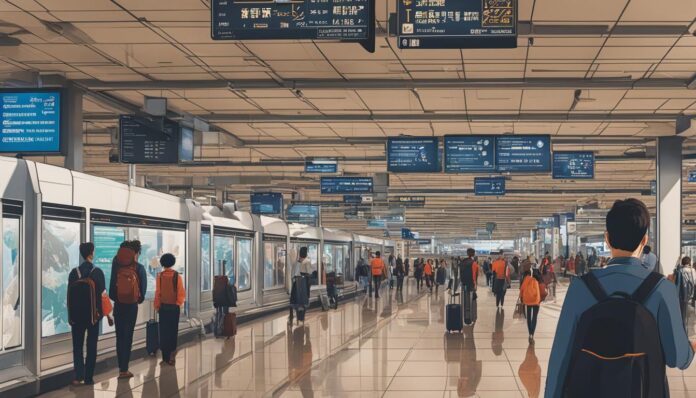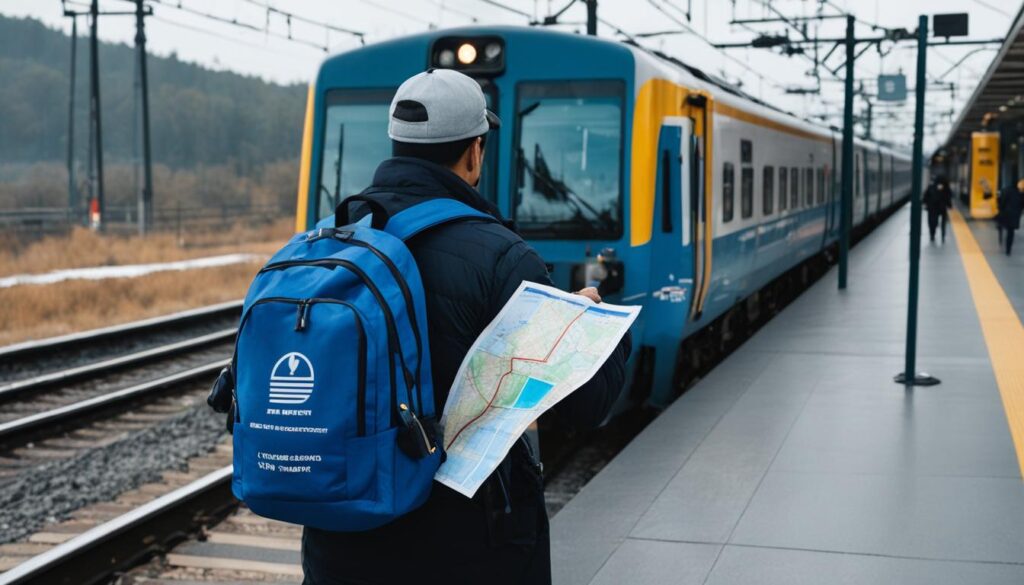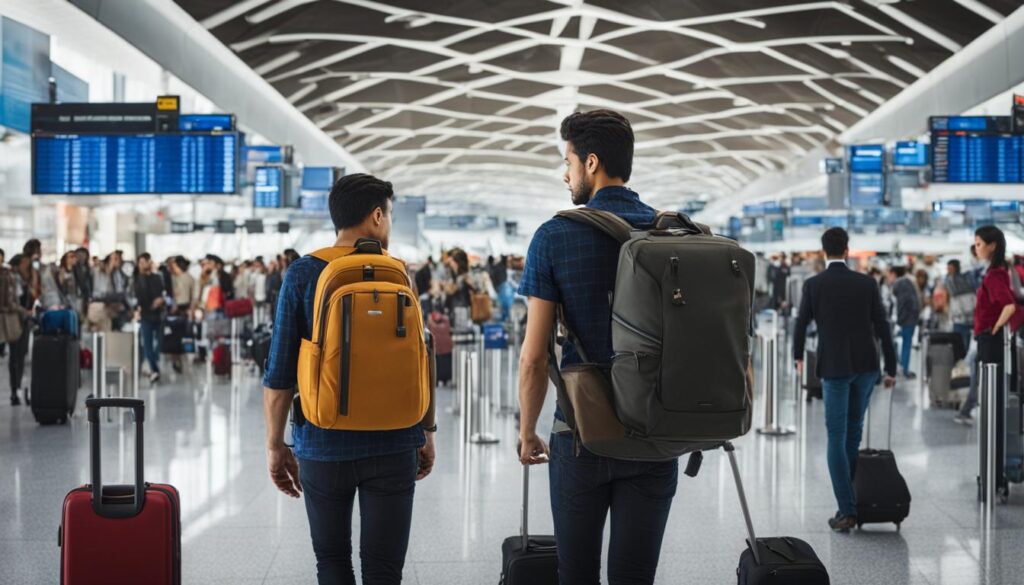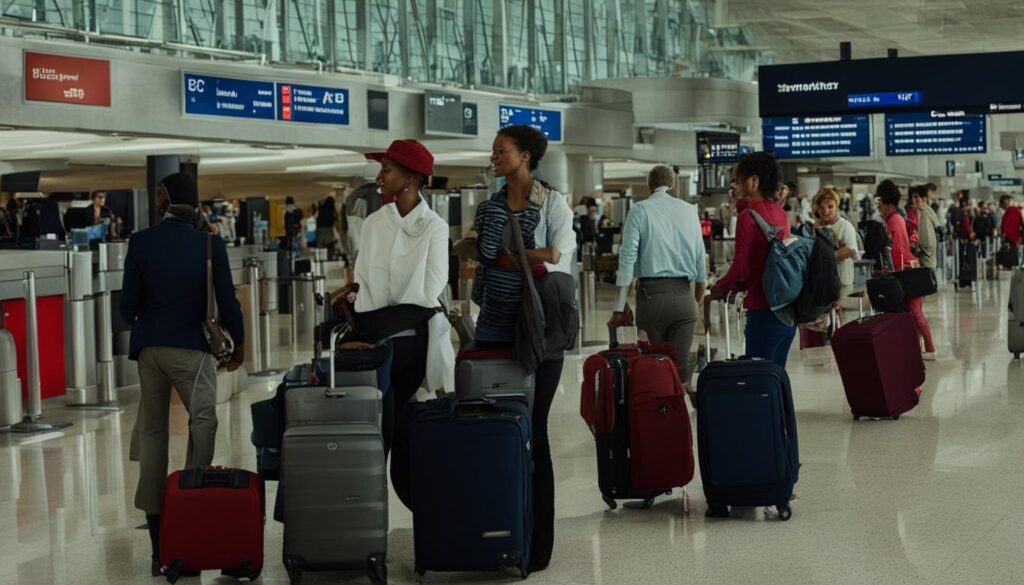Are you tired of feeling lost and overwhelmed while trying to navigate airports and train stations? With our expert guide, you’ll discover essential tips and information to make your travels stress-free. From airport transportation to train station directions, this guide has everything you need to know.
With detailed maps, insider insights, and valuable resources, you’ll be able to navigate airports and train stations like a pro. Say goodbye to the confusion and frustration that often come with travel, and hello to a smooth and enjoyable journey.
Whether you’re a seasoned traveler or a first-timer, this guide is for you. Read on to learn more about basic tips for using public transportation, planning for departure, layovers, making connections, accessibility, immigration procedures, and traveling with pets.
Getting Started: Basic Tips for Public Transportation
Using public transportation is an affordable and convenient way to get around, but it can also be overwhelming for first-timers. Here are some basic tips to help you get started:
1. Research Your Options
Before heading to the airport or train station, take some time to research the different types of public transportation available. Depending on your location, you may have access to buses, subways, trains, or a combination of these. Check schedules, routes, and fares online to plan your trip accordingly.
2. Purchase Tickets in Advance
Many public transportation services allow you to purchase tickets online or via mobile apps. This can save you time and make the ticketing process more straightforward. Depending on the provider, you may also be able to purchase passes or special deals that can save you money.
3. Check for Discounts
Some public transportation services offer discounts for seniors, students, or military personnel. If you fall under any of these categories, be sure to inquire about any available discounts. You can also check online for any promotional deals or group rates.
4. Check Airport and Train Station Information
Knowing your way around the airport or train station is essential for stress-free travel. Familiarize yourself with the airport or train station layout and facilities, such as baggage claim locations, security checkpoints, and transportation options. Check airport and train station websites to find maps, terminal information, and helpful guides.
5. Plan for Delays
Public transportation can be unpredictable, and delays can happen due to various reasons, including traffic, weather or technical issues. Therefore, make sure to plan some extra time for your journey and have backups like alternative routes, modes of transportation or contingency plans to minimize stress.
“Using public transportation can be a bit daunting at first, but with some basic planning and research, you’ll soon be traveling like a pro!”
Airport Navigation: Preparing for Departure
Heading to the airport can be a hassle, but with the right knowledge, you can breeze through check-in and security with ease. Here are some tips to help you prepare:
Plan your route
Before leaving your home or hotel, research the best transportation options to the airport. Consider factors like distance, traffic, and public transportation availability. If driving, make sure to check parking options and fees in advance.
Check-in online
Most airlines offer online check-in options, which can save you significant time and hassle at the airport. You can usually check-in up to 24 hours in advance and print your boarding pass or use a mobile boarding pass.
Prepare your documents
Gather all necessary travel documents, such as your passport or ID, boarding pass, and any necessary visas or travel permits. Place them in a readily accessible location, like a designated travel document folder or in a pocket. Be sure to check the TSA website for any restrictions on items you can carry.
Understand the airport layout
Check the airport map online before you arrive to get familiar with the layout. You can find information on the baggage claim, restrooms, and other facilities you may need to access.
Arrive early
Arrive at the airport at least two hours before your flight departure time to accommodate delays, security lines, and unforeseen circumstances.
Passing security
Be prepared to pass through security by avoiding wearing excess jewelry, wearing shoes you can easily take on and off, and having your laptop and liquids in accessible locations. Also, double-check TSA guidelines for items not allowed in your carry-on or checked baggage.
Navigating departure gates
After clearing security, review your boarding pass to find your assigned gate. Follow the signs to your gate and arrive at least 30 minutes before boarding time. To avoid missing your flight, set an alarm on your phone or watch as a reminder.
By following these tips, you’ll be prepared to navigate through the airport with ease and stress-free.
Train Station Navigation: Preparing for Your Trip
Train travel is a convenient and affordable way to get around, and navigating train stations can be simple with a little preparation. Here are some tips to help you find your way:
Check the Train Schedule
Before you head to the train station, check the train schedule to know the departure time and train number for your trip. You can usually find the schedule online or on a printed timetable. If you need assistance, many train stations have information booths where staff can provide schedules and answer your questions.
Find Your Platform
Once you arrive at the train station, look for the electronic boards or station announcements to determine your platform number. You can also find the platform number on your ticket or reservation. If you have any difficulty finding your platform, ask for assistance from the station staff.
Understand the Ticketing System
Train ticketing systems can vary between countries and train operators, so take some time to understand the system in advance. Some stations have self-service kiosks where you can purchase tickets, while others require you to purchase them at a ticket counter. If you’re unsure, ask a staff member for assistance.
| Amenities at Train Stations | Description |
|---|---|
| Restaurants and cafes | Grab a bite to eat before or after your trip, or enjoy a coffee or snack while waiting for your train. |
| Luggage storage | Stash your bags in a locker or storage facility if you need to explore the city before or after your train trip. |
| Restrooms | Most train stations have public restrooms available for your convenience. |
| Information booths or centers | Get help with train schedules, ticketing, and other information from knowledgeable staff. |
Train stations offer a variety of amenities to make your travel experience comfortable and enjoyable. Look for the following facilities when navigating train stations:
By understanding how to find your platform, read train schedules, and use the ticketing system, you’ll be ready for a successful and stress-free journey.
Airport Layovers: Making the Most of Your Time
Long layovers at airports can be dreaded, but with the right tips and mindset, they can become an opportunity to explore new places, even if you’re just at the airport. Here are some essential airport and train station navigation tips to help you make the most of your layovers:
Explore the Airport’s Amenities
Airports are more than just transportation hubs; they are mini-cities with plenty of amenities to keep you occupied during your layover. Check out restaurants, shops, spas, and lounges to make your stay more enjoyable. Some airports even have art exhibits or indoor gardens to explore. Use airport maps to navigate your way around.
Find Relaxation Areas
Traveling can be stressful, and a long layover can amplify that stress. Find designated relaxation areas at the airport to unwind, meditate, or simply take a nap. Bring noise-canceling headphones, an eye mask, and comfortable clothing to maximize your relaxation time.
Venture Out for Quick City Tours
If your layover is more than a few hours, consider venturing out of the airport for a quick city tour. Many airports offer city tours or public transportation options to nearby attractions. However, be sure to plan in advance, check visa requirements, and account for travel time, so you don’t miss your next flight or train.
With these airport and train station navigation tips, your layovers can become exciting opportunities for exploring new places, relaxing, and making the most of your travel time.
Connecting Flights and Train Transfers: Mastering Connections
Connecting flights and train transfers can be stressful if you don’t have an airport transportation guide or airport and train station information at hand. Here are some tips to make your travels more manageable:
- Plan Ahead: If you’re booking your flights or train tickets online, check the details of your connection before making the reservation. Leave enough time in case of delays or unexpected changes.
- Know your Terminal: Check the airport or train station map to familiarize yourself with the location of your connecting terminal. Make a note of the gate, platform, or baggage claim area.
- Get Your Boarding Passes: If you have multiple flights or trains, try to get all your boarding passes in advance to avoid waiting in line and save time.
- Follow the Signs: Look for signs that indicate transfer directions. Be mindful of any announcements and check monitor screens for updated information.
- Utilize Transportation: If you have a tight connection, consider using airport or train shuttle services to get to your next terminal more quickly.
Remember that navigating connections at airports or train stations takes time and patience. Don’t hesitate to ask for help or directions if you need them.
“A successful connection is all about preparation and mindfulness. Know your itinerary, pack your airport transportation guide, and stay alert.”
Accessibility at Airports and Train Stations: Travel for Everyone
Traveling can be challenging for people with disabilities or special needs. However, airports and train stations have taken steps to make travel more accessible for everyone. Here are some things to keep in mind if you are traveling with disabilities or special needs:
- Plan ahead: Before you travel, research your destination’s airports or train stations. Many have accessibility information available online, including maps, facilities, and services.
- Ask for assistance: If you require special assistance, contact your airline or train station beforehand. They can provide services such as wheelchair assistance, priority boarding, and assistance with luggage.
- Accessible transportation: Most airports and train stations offer accessible transportation options, such as shuttle services, accessible taxis, and wheelchair-accessible rental cars.
- Facilities: Airports and train stations have accessible restrooms, seating, and other facilities. Many also have sensory rooms or quiet areas for travelers with autism or other sensory sensitivities.
- Resources: If you need help navigating airports or train stations, many offer resources such as information desks, Braille maps, and accessible apps.
Remember, if you have any questions or concerns about accessibility, don’t hesitate to ask for help at the airport or train station.
“Accessibility is not just about ramps and grab bars. It’s about making sure everyone can fully participate in every aspect of public life.” – Tammy Duckworth
International Travel: Customs and Immigration
If you’re traveling internationally, navigating customs and immigration procedures at airports and train stations is an essential part of your journey. To ensure a stress-free experience, it’s crucial to understand and prepare for the necessary documents and security protocols. Here are some tips for a smooth transition through international borders:
Documents
Make sure you have all necessary travel documents before leaving for your trip. This typically includes a passport and visa, but requirements may vary depending on your destination and citizenship status. To avoid any complications or delays, research the specific requirements for your trip well in advance. Keep your documents organized and accessible while traveling.
Security Protocols
International travel requires rigorous security protocols to ensure safety and compliance with laws and regulations. When passing through customs and immigration, you may be asked to declare any items or goods you are bringing into the country. Be prepared to answer questions honestly and avoid bringing prohibited items. Follow instructions from officials and remain patient during the process.
Tips
To make the process smoother, arrive at the airport or train station well in advance of your departure time. Be aware of any restrictions on liquids, gels, or electronics in carry-on luggage. If you have any doubts or questions about the process, seek assistance from airport or train station personnel. Finally, be respectful of the customs and norms of the country you are visiting.
Traveling with Pets: Airport and Train Station Guidelines
Traveling with your furry friend is an exciting adventure, but it demands careful planning and preparation. Before heading to the airport or train station, you need to research specific guidelines and regulations for bringing your pet along with you. Here are some essential tips to make your journey comfortable and stress-free.
Airport and Train Station Information
Not all airports and train stations are pet-friendly, so it’s essential to check in advance what facilities are available for your pet. Different stations may have different policies, so make sure to check official websites or call customer service hotlines to get the most accurate information on things like:
- Pet relief areas within the stations
- Restrictions on pets in certain areas or travel classes
- Required documentation, such as vaccination records
Also, make sure to check the size and breed restrictions for your pet carrier, as airlines and train companies may have different regulations.
Tips for Finding Your Way in Airports and Train Stations
When traveling with a pet, it’s essential to arrive at the airport or train station in plenty of time to avoid rushing. Here are some additional tips to help you find your way:
- Consider purchasing a pet carrier backpack, which can make it easier to navigate and maneuver around crowds.
- Consult the airport or train station maps for pet relief areas and designated pet-friendly points.
- Ask the customer service desk at the airport or train station for assistance if you need help navigating or finding pet relief areas.
- Be mindful of other passengers and keep your pet in your carrier during the journey.
Conclusion
Now that you have learned expert tips and essential information from this comprehensive travel guide for airports and train stations, you can navigate these public transportation facilities like a pro. With the valuable insights, maps, and directions provided in this airport and train station navigation guide, you’ll be prepared for stress-free journeys. Remember to use the resources provided in this travel guide for airports and train stations to enhance your travel experience.
By utilizing these airport and train station navigation tips, you’ll be able to prepare for your departure at airports and train stations by planning your route, understanding the airport or train station’s layout and facilities, checking-in, passing security, and navigating departure gates. You’ll also master the process of navigating train stations by finding your platform, reading train schedules, and understanding ticketing systems while enhancing your travel experience with available amenities.
Whether you have layovers, connecting flights, or train transfers, this travel guide for airports and train stations has got you covered. You’ll learn about accessing city tours, finding relaxation areas, making efficient use of your time, discovering accessibility options designed to assist travelers with disabilities or special needs, navigating customs and immigration procedures, and guidelines and regulations for bringing pets to airports and train stations.
With this comprehensive airport transportation guide, you now have all the necessary tools and the knowledge to travel with confidence and ease. Happy travels!

















































